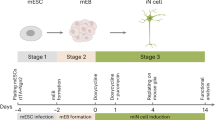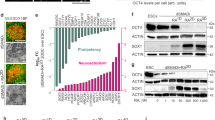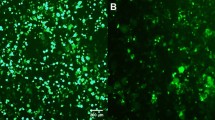Abstract
Numerous gene and cell therapy strategies are being developed for the treatment of neurodegenerative disorders. Many of these strategies use constitutive expression of therapeutic transgenic proteins, and although functional in animal models of disease, this method is less likely to provide adequate flexibility for delivering therapy to humans. Ligand-inducible gene expression systems may be more appropriate for these conditions, especially within the central nervous system (CNS). Mifepristone’s ability to cross the blood–brain barrier makes it an especially attractive ligand for this purpose. We describe the production of a mifepristone-inducible vector system for regulated expression of transgenes within the CNS. Our inducible system used a lentivirus-based vector platform for the ex vivo production of mifepristone-inducible murine neural progenitor cells that express our transgenes of interest. These cells were processed through a series of selection steps to ensure that the cells exhibited appropriate transgene expression in a dose-dependent and temporally controlled manner with minimal background activity. Inducible cells were then transplanted into the brains of rodents, where they exhibited appropriate mifepristone-inducible expression. These studies detail a strategy for regulated expression in the CNS for use in the development of safe and efficient gene therapy for neurological disorders.
This is a preview of subscription content, access via your institution
Access options
Subscribe to this journal
Receive 12 print issues and online access
$259.00 per year
only $21.58 per issue
Buy this article
- Purchase on Springer Link
- Instant access to full article PDF
Prices may be subject to local taxes which are calculated during checkout








Similar content being viewed by others
References
Behrstock S, Ebert A, McHugh J, Vosberg S, Moore J, Schneider B et al. Human neural progenitors deliver glial cell line-derived neurotrophic factor to parkinsonian rodents and aged primates. Gene Therapy 2006; 13: 379–388.
Cress DE . The need for regulatable vectors for gene therapy for Parkinson's disease. Exp Neurol 2008; 209: 30–33.
Naidoo J, Young D . Gene regulation systems for gene therapy applications in the central nervous system. Neurol Res Int 2012; 2012: 595410.
Marmorstein R, Carey M, Ptashne M, Harrison SC . DNA Recognition by GAL4: structure of a protein–DNA complex. Nature 1992; 356: 408–414.
Wang Y, O'Malley BW Jr, Tsai SY, O'Malley BW . A regulatory system for use in gene transfer. Proc Natl Acad Sci USA 1994; 91: 8180–8184.
Wang Y, Xu J, Pierson T, O'Malley BW, Tsai SY . Positive and negative regulation of gene expression in eukaryotic cells with an inducible transcriptional regulator. Gene Therapy 1997; 4: 432–441.
Burcin MM, Schiedner G, Kochanek S, Tsai SY, O'Malley BW . Adenovirus-mediated regulable target gene expression in vivo. Proc Natl Acad Sci USA 1999; 96: 355–360.
Pierson TM, Wang Y, DeMayo FJ, Matzuk MM, Tsai SY, Omalley BW . Regulable expression of inhibin A in wild-type and inhibin alpha null mice. Mol Endocrinol 2000; 14: 1075–1085.
Nordstrom JL . The antiprogestin-dependent GeneSwitch system for regulated gene therapy. Steroids 2003; 68: 1085–1094.
Takagi M, Yamakawa H, Watanabe T, Suga T, Junji Y . Inducible expression of long-chain acyl-CoA hydrolase gene in cell cultures. Mol Cell Biochem 2003; 252: 379–385.
Schilliger KJ, Tsai SY, Taffet GE, Reddy AK, Marian AJ, Entman ML et al. Regulatable atrial natriuretic peptide gene therapy for hypertension. Proc Natl Acad Sci USA 2005; 102: 13789–13794.
Emelyanov A, Parinov S . Mifepristone-inducible LexPR system to drive and control gene expression in transgenic zebrafish. Dev Biol 2008; 320: 113–121.
Maddalena A, Tereshchenko J, Bähr M, Kügler S . Adeno-associated virus-mediated, mifepristone-regulated transgene expression in the brain. Mol Ther Nucleic Acids 2013; 2: e106.
Mankodi A, Wheeler TM, Shetty R, Salceies KM, Becher MW, Thornton CA . Progressive myopathy in an inducible mouse model of oculopharyngeal muscular dystrophy. Neurobiol Dis 2012; 45: 539–546.
Zufferey R, Dull T, Mandel RJ, Bukovsky A, Quiroz D, Naldini L, Trono D . Self-inactivating lentivirus vector for safe and efficient in vivo gene delivery. J Virol 1998; 12: 9873–9880.
Pelletier J, Sonenberg N . Internal initiation of translation of eukaryotic mRNA directed by a sequence derived from poliovirus RNA. Nature 1988; 334: 320–325.
Lothian C, Lendahl U . An evolutionary conserved region in thr second intron of the human nestin gene directs gene expression to CNS progenitor cells and to early neural crest cells. Eur J Neurosci 1997; 9: 452–462.
Mullick A, Katzenellenbogen BS . Progesterone receptor synthesis and degradation in MCF-7 human breast cancer cells as studied by dense amino acid incorporation. Evidence for a non-hormone binding receptor precursor. J Biol Chem 1986; 261: 13236–13246.
Lonard DM, Nawaz Z, Smith CL, O’Malley BW . The 26S proteasome is required for estrogen receptor-alpha and coactivator turnover and for efficient estrogen receptor-alpha transactivation. Mol Cell 2000; 5: 939–948.
Corish P, Tyler-Smith C . Attenuation of green fluorescent protein half-life in mammalian cells. Protein Eng 1999; 12: 1035–1040.
Kaster KR, Burgett SG, Rao RN, Ingolia TD . Analysis of a bacterial hygromycin B resistance gene by transcriptional and translational fusions and by DNA sequencing. Nucleic Acids Res 1983; 11: 6895–6911.
Verkhusha VV, Kuznetsova IM, Stepanenko OV, Zaraisky AG, Shavlovsky MM, Turoverov KK et al. High stability of Discosoma DsRed as compared to Aequorea EGFP. Biochemistry 2003; 42: 7879–7884.
Ebert AD, Barber AE, Heins BM, Svendsen CN . Ex vivo delivery of GDNF maintains motor function and prevents neuronal loss in a transgenic mous model of Huntington’s disease. Exp Neurol 2010; 224: 155–162.
Krum JM, Rosenstein JM . Transient coexpression of nestin, GFAP, and vascular endothelial growth factor in mature reactive astroglia following neural grafting or brain wounds. Exp Neurol 1999; 160: 348–360.
Roll L, Faissner A . Influence of the extracellular matrix on endogenous and transplanted stem cells after brain damage. Front Cell Neurosci 2014; 8: 219.
Carpenter AE, Jones TR, Lamprecht MR, Clarke C, Kang IH, Friman O et al. CellProfiler: image analysis software for identifying and quantifying cell phenotypes. Genome Biol 2006; 7: R100.
Gruh I, Martin U . Transdifferentiation of stem cells: a critical review. In: Martin U, Scheper T (eds). Engineering of Stem Cells. Springer Science & Business Media: Berlin, Germany, 2009, pp 94–96.
Schneider CA, Rasband WS, Eliceiri KW . NIH Image to ImageJ: 25 years of image analysis. Nat Methods 2012; 9: 671–675.
Fillat C, Carrió M, Cascante A, Sangro B . Suicide gene therapy mediated by the Herpes Simplex virus thymidine kinase gene/Ganciclovir system: fifteen years of application. Curr Gene Ther 2003; 3: 13–26.
Ebert AD, Beres AJ, Barber AE, Svendsen CN . Human neural progenitor cells over-expressing IGF-1 protect dopamine neurons and restore function in a rat model of Parkinson’s disease. Exp Neurol 2008; 209: 213–223.
Kitiyanant N, Kitiyanant Y, Svendsen CN, Thangnipon W . BDNF-, IGF-1 and GDNF-secreting human neural progenitor cells rescue amyloid β-induced toxicity in cultured rat septal neurons. Neurochem Res 2012; 37: 143–152.
Krakora D, Mulcrone P, Meyer M, Lewis C, Bernau K, Gowing G et al. Synergistic effects of GDNF and VEGF on lifespan and disease progression in a familial ALS rat model. Mol Ther 2013; 21: 1602–1610.
Snyder EY, Taylor RM, Wolfe JH . Neural progenitor cell engraftment corrects lysosomal storage throughout the MPS VII mouse brain. Nature 1995; 374: 367–370.
Svendsen CN, Clarke DJ, Rosser AE, Dunnett SB . Survival and differentiation of rat and human epidermal growth factor-responsive precursor cells following grafting into the lesioned adult central nervous system. Exp Neurol 1996; 137: 376–388.
Flax JD, Aurora S, Yang C, Simonin C, Wills AM, Billinghurst LL et al. Engraftable human neural stem cells respond to developmental cues, replace neurons, and express foreign genes. Nat Biotechnol 1998; 16: 1033–1039.
Gage FH . Mammalian neural stem cells. Science 2000; 287: 1433–1438.
Tamaki S, Eckert K, He D, Sutton R, Doshe M, Jain G et al. Engraftment of sorted/expanded human central nervous system stem cells from fetal brain. J Neurosci Res 2002; 69: 976–986.
McBride JL, Behrstock SP, Chen EY, Jakel RJ, Siegel I, Svendsen CN et al. Human neural stem cell transplants improve motor function in a rat model of Huntington's disease. Journal Comp Neurol 2004; 475: 211–219.
Kelly S, Bliss TM, Shah AK, Sun GH, Ma M, Foo WC et al. Transplanted human fetal neural stem cells survive, migrate, and differentiate in ischemic rat cerebral cortex. Proc Natl Acad Sci USA 2004; 101: 11839–11844.
Muller FJ, Snyder EY, Loring JF . Gene therapy: can neural stem cells deliver? Nat Rev Neurosci 2006; 7: 75–84.
Griffin TA, Anderson HC, Wolfe JH . Ex vivo gene therapy using patient iPSC-derived NSCs reverses pathology in the brain of a homologous mouse model. Stem Cell Rep 2015; 4: 835–846.
Cummings BJ, Uchida N, Tamaki SJ, Salazar DL, Hooshmand M, Summers R et al. Human neural stem cells differentiate and promote locomotor recovery in spinal cord-injured mice. Proc Natl Acad Sci USA 2005; 102: 14069–14074.
Corti O, Sabate O, Horellou P, Colin P, Dumas S, Buchet D et al. A single adenovirus vector mediates doxycycline-controlled expression of tyrosine hydroxylase in brain grafts of human neural progenitors. Nat Biotechnol 1999; 17: 349–354.
Takahashi K, Tanabe K, Ohnuki M, Narita M, Ichisaka T, Tomoda K et al. Induction of pluripotent stem cells from adult human fibroblasts by defined factors. Cell 2007; 131: 861–872.
Yu J, Vodyanik MA, Smuga-Otto K, Antosiewicz-Bourget J, Frane JL, Tian S et al. Induced pluripotent stem cell lines derived from human somatic cells. Science 2007; 318: 1917–1920.
Sareen D, Gowing G, Sahabian A, Staggenborg K, Paradis R, Avalos P et al. Human induced pluripotent stem cells are a novel source of neural progenitor cells (iNPCs) that migrate and integrate in the rodent spinal cord. J Comp Neurol 2014; 522: 2707–2728.
Miyoshi H, Blomer U, Takahashi M, Gage FH, Verma IM . Development of a self-inactivating lentivirus vector. J Virol 1998; 72: 8150–8157.
Heuer GG, Skorupa AF, Prasad Alur RK, Jiang K, Wolfe JH . Accumulation of abnormal amounts of glycosaminoglycans in murine mucopolysaccharidosis type VII neural progenitor cells does not alter the growth rate or efficiency of differentiation into neurons. Mol Cell Neurosci 2001; 17: 167–178.
Boockvar JA, Kapitonov D, Kapoor G, Schouten J, Counelis GJ, Bogler O et al. Constitutive EGFR signaling confers a motile phenotype to neural stem cells. Mol Cell Neurosci 2003; 24: 1116–1130.
Hahne F, LeMeur N, Brinkman RR, Ellis B, Haaland P, Sarkar D et al. flowCore: a Bioconductor package for high throughput flow cytometry. BMC Bioinform 2009; 10: 106.
Gentleman RC, Carey VJ, Bates DM, Bolstad B, Dettling M, Dudoit S et al. Bioconductor: open software development for computational biology and bioinformatics. Genome Biol 2004; 5: R80.
RStudio RStudio: Integrated development environment for R (Version 0.98.501). Computer software: Boston, MA, USA, 2013. Available at: http://www.rstudio.org accessed 11 December 2014.
Acknowledgements
We are grateful to Trena Clarke (University of Pennsylvania), Kelli DeJohn, Jacalyn McHugh, Roksana Elder, Weidong Xiong and Vaithi Arumugaswami (CSMC) for their logistical and technical help, personal assistance and advice. We also appreciate the technical assistance from the Protein Expression Laboratory at NCI-Frederick, the Vector Core at the University of Pennsylvania and the Vector Core (Arumugaswami) laboratory of the Cedars-Sinai Regenerative Medicine Institute. Assistance from the members of several flow cytometry core laboratories was especially appreciated, including Brion Shreffler (University of Pennsylvania), Martha Kirby and Stacie Anderson (NHGRI/NIH) as well as Patricia Lin and Gillian Hultin (Cedars-Sinai Medical Center). We would also like to thank Barrington Burnett (NINDS/NIH) and Mark Burcin (Baylor College of Medine) and Soshana Svendsen (Cedars-Sinai) for advice and critical analysis. We also thank the NIH AIDS Reagent Program, Webster Cavenee (Ludwig Institute for Cancer Research), Steven Goldman (University of Rochester), Hansjörg Hauser (Universität Oldenburg) and Tyler Jacks (MIT) for the generous gifts of plasmids. This research was supported in part by NIH Grant T32-HD043021-04 (to TMP), NIH R01-NS08867 Grant (to JHW), the Intramural Research Program of the NIH/NINDS (to KF) and Cedars-Sinai Medical Center and Board of Governors Regenerative Medicine Institute institutional funding (to CNS, TMP). TMP was also supported by the Diana and Steve Marienhoff Fashion Industries Guild Endowed Fellowship in Pediatric Neuromuscular Diseases.
Author information
Authors and Affiliations
Corresponding author
Ethics declarations
Competing interests
The authors declare no conflict of interest.
Additional information
Supplementary Information accompanies this paper on Gene Therapy website
Supplementary information
Rights and permissions
About this article
Cite this article
Hjelm, B., Grunseich, C., Gowing, G. et al. Mifepristone-inducible transgene expression in neural progenitor cells in vitro and in vivo. Gene Ther 23, 424–437 (2016). https://doi.org/10.1038/gt.2016.13
Received:
Revised:
Accepted:
Published:
Issue Date:
DOI: https://doi.org/10.1038/gt.2016.13
This article is cited by
-
A reversible RNA on-switch that controls gene expression of AAV-delivered therapeutics in vivo
Nature Biotechnology (2020)



